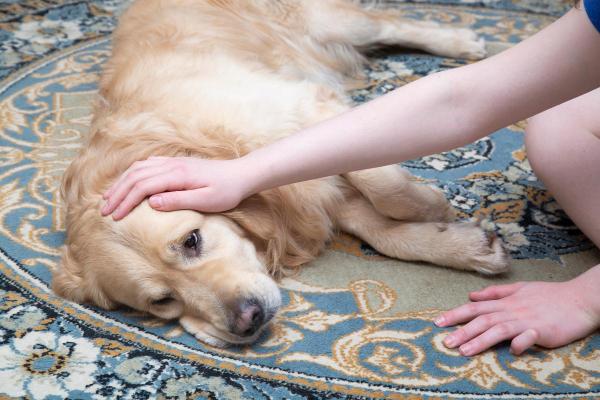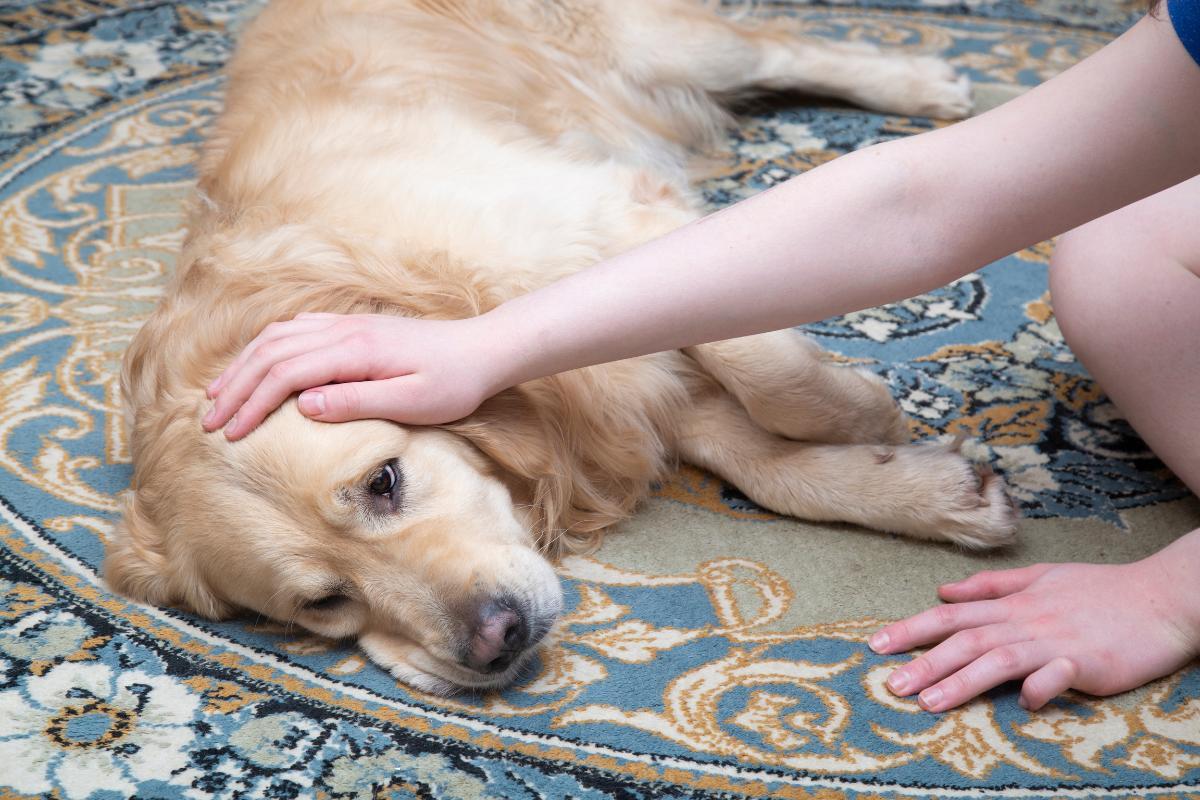My Dog Is Twitching While Lying Down



See files for Dogs
A dog twitches when they lie down due to tremors and muscle contractions. While this twitching can be a normal response to physical activity, it can also be a symptom of certain physiological or emotional pathologies. While we can recognize tremors or twitching easily in the dog, it is more difficult to determine this underlying cause. Since some of the reasons why a dog has trouble lying down or is shaking when they do so can be serious, it is very important we do not ignore this behavior. If a dog is regularly shaking when they lay down, you will need to take them to a veterinarian for assessment.
We discover the reasons why my dog is twitching while lying down. AnimalWised looks at the various reasons for this behavior and what treatment options might be available.
Exercise
Before we look at some of the pathological reasons a dog is shaking when lying down, we need to remember the importance of context. The medical word for an involuntary arrhythmic twitching of a muscle or joint is myoclonus. Myoclonus jerks or twitches will happen to all dogs at some point, but if they occur regularly or acutely, it can be a sign of a disorder[1].
Some dogs are more prone to myoclonus twitches than others. A common example is the Greyhound. They are known for their more regular displays of myoclonus, something which is believed to be due to their high density of muscle fibers[2].
Exercise is also an important factor. When a dog has been exercising vigorously, their muscles have been given a workout. Since a dog may want to rest due to tiredness, they may twitch when lying down due to the effect of physical strain. This is normal and won't be a sign of a problem unless it is prolonged and is accompanied by other symptoms.
Another common type of myoclonus is when the dog is asleep. They may not twitch during the action of lying down, but REM sleep can provoke twitches which are completely normal. Learn more with our article on why my dog is shaking when sleeping.
Poisoning
When the myoclonus is not a natural response in the body, we need to look for some underlying causes. When a dog ingests or is exposed to certain toxic substances, tremors and twitching can be a symptom. Since their organism is affected, the dog may try to lie down because of the toxic shock response. Other associated symptoms include pupillary dilation, vestibular signs, seizures, increased body temperature, tachycardia and gastrointestinal signs.
Various substances can cause poisoning in dogs. These can be illegal drugs such as cocaine, LSD or amphetamine, but it can also be a reaction to medications. Some animals may have a sensitivity or allergy to a drug, causing the dog to go into anaphylactic shock. Others may experience an overdose or have a reaction with another medication causing symptoms such as tremors.
In most cases these substances have very specific antidotes that are widely known by veterinarians. In addition, the treatment can be complemented with dexmedetomidine to reduce tremors or anticonvulsants such as diazepam for dogs, as well as other drugs.

Neurological diseases
While there are physiological problems which can cause a dog's leg to twitch, it is important to know that neurological problems are an important consideration. The dog's brain will send signals to the rest of their body to carry out various actions as part of their nervous system. Neurological disorders can confuse these signals and causes nerves to twitch in various parts of the body.
Diseases located in the cerebellum, thalamus, specific nuclei or the brain can present tremors as the main symptom apart from postural deficits. Some of the most well-known diseases that can cause tremors are:
- Meningitis
- Meningoencephalomyelitis
- Encephalitis
Many of these neurological diseases can be caused by microorganisms such as bacteria, viruses or protozoa. For this reason, a specific diagnosis of the causative agent is needed. There are also diseases of the immune system or of idiopathic (unknown) origin that can affect the nervous system. We must take them into account if we do not find signs of infection.
Treatment of these neurological problems can be difficult and are complicated by potential brain damage. If the disease causes temporary neurological disorders, treatment should stop the twitching when the dog is lying down and other symptoms. Treatment can be in the form of antibiotics for bacterial infection or corticosteroids in the case of immune-mediated diseases, as well as others depending on the cause.
There is also a neurological disease called idiopathic generalized tremor syndrome (IGTS)[3]. This is of unknown origin and characterized by dogs that present generalized tremors in middle age. In addition to twitching when lying down, affected dogs also display symptoms such as anxiety, hyperthermia, opisthotonos (eye tremor), motor incoordination or head drooping.
Treatment is usually based on corticosteroids at long-term immunosuppressive doses and controlling tremors with benzodiazepines or propranolol. They usually have a good prognosis. If your dog suffers from any of the symptoms discussed above along with tremors, we recommend visiting a veterinarian as soon as possible. Specifically, you may want to speak to a veterinarian specializing in neurology.
Neurological problems in older dogs are more common. This is due to the deleterious effects of aging, but other factors can be involved.
Psychological disorders
Dogs can suffer from behavioral disorders that manifest themselves through tremors when at rest. In the case of phobias or radical fears, dogs usually show twitching along with excessive howling, seeking shelter, spontaneous urination or dilated pupils. This problem usually manifests itself in situations in which the dog has an exaggerated reaction to a specific stimulus or to a circumstance that has been related to something negative.
For example, dogs afraid of fireworks usually exhibit this behavior in response to their fear of the noise produced by explosions and loud bangs. Any situation in which the pet feels afraid can cause a similar reaction.
Fear in dogs is mitigated by education and training, with the socialization period being particularly important for engendering an even temperament. Puppies that have been removed from their mother and siblings prematurely often show signs of excessive fear when they are older. This is because they do not learn certain coping mechanisms which provide security as they develop.
The most important socialization period for puppies is between the ages of 3 to 12 weeks. During this time, the young dog should be exposed to various stimuli. Such exposure allows them to know what to fear and what not to fear. Even after this time, we should maintain regular socialization with other animals, people and environments. We learn more with our article on how to socialize an adult dog.
Separation anxiety or stress
Although considered to be psychological disorders, separation anxiety and stress deserve special mention due to their prevalence in dogs. Separation anxiety in particular can cause the dog to twitch when lying down, especially if they observe their guardian leaving them alone.
Dogs establish relationships with their owners which are based on lived experiences. They internalize this experience in a different way to humans. This means that situations which present a possible or even perceived threat can lead to behavioral disorders in dogs that are difficult to correct.
This is why we often see trembling in dogs that have experienced trauma, abuse or neglect. Many dogs waiting in animal shelters to be adopted have experienced these issues and have a difficult time relating to people. They may also elicit a fear response that manifests in twitching when they are exposed to specific stimuli.
Neglect doesn't always mean a guardian is actively abusive. Many dog owners think they are providing all the love their dog needs, but may neglect practical care necessities such as education and training. Doing so can lead to a quicker stress response and behavioral problems later in life.
Separation anxiety in dogs often occurs when we provide the wrong kind of care. While we may think we are being loving, not allowing a dog to have certain levels of independence can be detrimental. When they become overly dependent on us, they will experience acute anxiety when we leave them alone. This can be problematic for neighbors and very harmful for the dog's health.
Learn about the breeds which are more prone to separation anxiety than others with our related guide.
Temperature
Another very common cause of resting tremors in dogs is cold. The body begins to generate spontaneous contractions to increase body temperature. This situation usually occurs first during exposure to extremely cold temperatures, so if you notice that the dog begins to shake and other symptoms such as paleness appear, the dog must be taken to a warmer animal.
The dog often twitches when lying down because they are trying to curl up somewhere warm. If the dog continues to twitch due to cold, we will need to provide them with a more comfortable space. This could involve central heating to raise the ambient temperature, but a good option is to use an electric heating blanket to warm the dog.

Pain
When a dog is experiencing pain, a common response is for them to shake and tremble. They will often twitch when they lie down because laying down can help ease the pain. Pain can be the result of a traumatic experience such as a traffic collision or a fight with another dog.
Various diseases can also cause pain in the dog which results in myoclonus. These can be cardiovascular, metabolic or infectious, among many others. In order to determine why your dog is twitching when lying down, it is vital you take your dog to a veterinarian. As this article shows, there are various possible reasons for this symptom. Only a veterinarian can provide a differential diagnosis and provide the most appropriate course of treatment.

This article is purely informative. AnimalWised does not have the authority to prescribe any veterinary treatment or create a diagnosis. We invite you to take your pet to the veterinarian if they are suffering from any condition or pain.
If you want to read similar articles to My Dog Is Twitching While Lying Down, we recommend you visit our Other health problems category.
1. Lowrie, M., & Garosi, L. (2017). Classification of Involuntary Movements in Dogs: Myoclonus and Myotonia. Journal of veterinary internal medicine, 31(4), 979–987.
https://doi.org/10.1111/jvim.14771
2. Guy, P. S., & Snow, D. H. (1981). Skeletal muscle fibre composition in the dog and its relationship to athletic ability. Research in veterinary science, 31(2), 244–248.
https://pubmed.ncbi.nlm.nih.gov/6459629/
3. Phillipps, S., DeDecker, S., Gutierrez-Quintana, R., Alcoverro, E., Gomes, S. A., & Goncalves, R. (2022). Idiopathic generalised tremor syndrome in dogs. The Veterinary record, 191(9), e1734. https://doi.org/10.1002/vetr.1734







